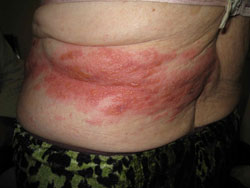The Toronto Dermatology Centre is one of the top places in Canada to manage your skin infections such as varicella zoster virus (“Shingles”). Our staff of outstanding dermatologists offer both a comprehensive assessment and diagnosis of your skin, but also discuss all the treatment options.
 Herpes zoster, also known as shingles or zoster, is a viral infection caused by the same virus that causes chicken pox. After chickenpox, the virus remains dormant (inactive), in certain nerve cells of the body, and when it reactivates it causes zoster. About 20% of those people who have had chicken pox will get zoster. Most people get zoster only once.
Herpes zoster, also known as shingles or zoster, is a viral infection caused by the same virus that causes chicken pox. After chickenpox, the virus remains dormant (inactive), in certain nerve cells of the body, and when it reactivates it causes zoster. About 20% of those people who have had chicken pox will get zoster. Most people get zoster only once.
It is not clear what makes the virus reactivate or “awaken.” A temporary weakness in immunity (the body’s ability to fight infection) may cause the virus to multiply and move along nerve fibers toward the skin. Zoster is most common in people over the age 50. Illness, trauma, and stress may also trigger zoster.
People with a weakened immunity for any reason like cancers, leukemia or lymphoma, and AIDS are prone to developing zoster. Medical treatments like chemotherapy or radiation for cancer, drugs taken to prevent rejection of transplanted organs, and cortisone taken for a long time, can make someone susceptible.
What are the Symptoms of Zoster?
First, there may be burning, itching, tingling, or extreme sensitivity in one area of the skin usually limited to one side of the body. This may be present for 1-3 days before a red rash appears at that site, and the rash soon turns into groups of blisters. The blisters generally last for 2-3 weeks. The blisters start out clear but then look yellow or bloody before they crust over (scab) and disappear.
Where Does Zoster Usually Appear on the Body?
Zoster is most common on the trunk and buttocks, but it can also appear on the face, arms, or legs if nerves in these areas are involved. Great care is needed if the blisters involve the eye because permanent eye damage can result. Blisters on the tip of the nose signal possible eye involvement.
What are the Complications of Herpes Zoster?
Post-herpetic neuralgia is pain, numbness, itching, and tingling that lasts long after the zoster rash clears. Post-herpetic neuralgia can continue after the skin has healed, or can last for months or even years. It is more common in older people. The use of medication in the early stages of zoster may help prevent this complication.
A bacterial infection of the blisters can occur and can delay healing. If pain and redness increase or reappear you should return to your dermatologist. Antibiotic treatment may be needed. An infection in association with zoster lesions can lead to scarring if not appropriately treated in a timely manner.
If zoster affects the eye and is not treated early, it can lead to complications like glaucoma, scarring, and blindness.
 How is Zoster Diagnosed?
How is Zoster Diagnosed?
The diagnosis is based on the way the blisters look and a history of pain before the rash on one side of the body. The blister fluid containing the virus is sometimes sent to the laboratory for special testing. Occasionally a skin biopsy is performed.
If Someone Has Zoster, is There any Reason to Worry About a More Serious Disease or a Poorly Functioning Immune System?
Most people with zoster are healthy. However, sick people or those with HIV are at risk. A chest x-ray or blood tests may be done.
Is Zoster Contagious?
Zoster is much less contagious than chicken pox. Persons with zoster can transmit the virus if blisters are broken. Newborns or those with decreased immunity are at the highest risk for contracting chicken pox from someone who has zoster.
Is There Much Scarring?
Scarring usually occurs only after more severe infections, especially in people with weakened immune systems, elderly persons, or blisters that become infected.
What is the Treatment For Zoster?
Zoster usually clears on its own in a few weeks and seldom recurs. Pain relievers and cool compresses are helpful in drying the blisters. If diagnosed early, oral anti-viral drugs (eg. Valtrex, Famvir, Acyclovir) can be prescribed to decrease both viral shedding and the duration of skin lesions. They are routinely prescribed for severe cases of zoster, cases with eye involvement, and for those with decreased immunity. The earlier treatment is started the better. The drugs may rarely cause headache, stomach upset, or lightheadedness.
Post-herpetic neuralgia can be treated with pain relievers, anti-depressants (e.g. amitryptiline, nortriptyline), and/or anti-seizure medicines (e.g. gabapentin, pregabalin).
A preventative vaccine called Zostavax is now on the market in Canada and recommended for persons older than 60 years of age. It reduces the risk of developing shingles by approximately 51% and reduces the risk of long-term pain after the shingles by 73%. Speak to your family physician / general practitioner to see if Zostavax is right for you.
